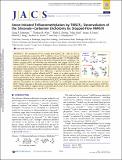Files in this item
Anion-initiated trifluoromethylation by TMSCF3 : deconvolution of the siliconate–carbanion dichotomy by stopped-flow NMR/IR
Item metadata
| dc.contributor.author | Johnston, Craig P. | |
| dc.contributor.author | West, Thomas H. | |
| dc.contributor.author | Dooley, Ruth E. | |
| dc.contributor.author | Reid, Marc | |
| dc.contributor.author | Jones, Ariana B. | |
| dc.contributor.author | King, Edward J. | |
| dc.contributor.author | Leach, Andrew G. | |
| dc.contributor.author | Lloyd-Jones, Guy C. | |
| dc.date.accessioned | 2018-11-26T16:32:59Z | |
| dc.date.available | 2018-11-26T16:32:59Z | |
| dc.date.issued | 2018-09-05 | |
| dc.identifier | 256704999 | |
| dc.identifier | 2368b527-734a-4855-b2d7-7de253a725f0 | |
| dc.identifier | 85052364892 | |
| dc.identifier.citation | Johnston , C P , West , T H , Dooley , R E , Reid , M , Jones , A B , King , E J , Leach , A G & Lloyd-Jones , G C 2018 , ' Anion-initiated trifluoromethylation by TMSCF 3 : deconvolution of the siliconate–carbanion dichotomy by stopped-flow NMR/IR ' , Journal of the American Chemical Society , vol. 140 , no. 35 , pp. 11112-11124 . https://doi.org/10.1021/jacs.8b06777 | en |
| dc.identifier.issn | 0002-7863 | |
| dc.identifier.other | crossref: 10.1021/jacs.8b06777 | |
| dc.identifier.other | ORCID: /0000-0003-2459-1872/work/51261135 | |
| dc.identifier.uri | https://hdl.handle.net/10023/16552 | |
| dc.description | The research leading to these results has received funding from the European Research Council under the European Union’s Seventh Framework Programme (FP7/2007–2013)/ERC grant agreement no. 340163. The Carnegie Trust provided a collaborative research grant. C.P.J. thanks the EC for an International Outgoing Fellowship (PIOF-GA-2013-627695). | en |
| dc.description.abstract | The mechanism of CF3 transfer from R3SiCF3 (R = Me, Et, iPr) to ketones and aldehydes, initiated by M+X– (<0.004 to 10 mol %), has been investigated by analysis of kinetics (variable-ratio stopped-flow NMR and IR), 13C/2H KIEs, LFER, addition of ligands (18-c-6, crypt-222), and density functional theory calculations. The kinetics, reaction orders, and selectivity vary substantially with reagent (R3SiCF3) and initiator (M+X–). Traces of exogenous inhibitors present in the R3SiCF3 reagents, which vary substantially in proportion and identity between batches and suppliers, also affect the kinetics. Some reactions are complete in milliseconds, others take hours, and others stall before completion. Despite these differences, a general mechanism has been elucidated in which the product alkoxide and CF3– anion act as chain carriers in an anionic chain reaction. Silyl enol ether generation competes with 1,2-addition and involves protonation of CF3– by the α-C–H of the ketone and the OH of the enol. The overarching mechanism for trifluoromethylation by R3SiCF3, in which pentacoordinate siliconate intermediates are unable to directly transfer CF3– as a nucleophile or base, rationalizes why the turnover rate (per M+X– initiator) depends on the initial concentration (but not identity) of X–, the identity (but not concentration) of M+, the identity of the R3SiCF3 reagent, and the carbonyl/R3SiCF3 ratio. It also rationalizes which R3SiCF3 reagent effects the most rapid trifluoromethylation, for a specific M+X– initiator. | |
| dc.format.extent | 13 | |
| dc.format.extent | 3679537 | |
| dc.language.iso | eng | |
| dc.relation.ispartof | Journal of the American Chemical Society | en |
| dc.subject | QD Chemistry | en |
| dc.subject | NDAS | en |
| dc.subject | BDC | en |
| dc.subject | R2C | en |
| dc.subject.lcc | QD | en |
| dc.title | Anion-initiated trifluoromethylation by TMSCF3 : deconvolution of the siliconate–carbanion dichotomy by stopped-flow NMR/IR | en |
| dc.type | Journal article | en |
| dc.contributor.institution | University of St Andrews. School of Chemistry | en |
| dc.identifier.doi | 10.1021/jacs.8b06777 | |
| dc.description.status | Peer reviewed | en |
This item appears in the following Collection(s)
Items in the St Andrews Research Repository are protected by copyright, with all rights reserved, unless otherwise indicated.

